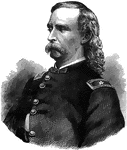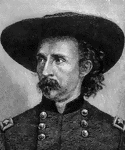Clipart tagged: ‘General Custer’

General Custer
General George Armstrong Custer with a Union spy. Custer is most known for his "last stand" at the Battle…

George Custer
"General George A. Custer, born in New Rumley, Harrison County, Ohio, December 5th, 1839, died in Montana,…

George Armstrong Custer
"George Armstrong Custer, a brilliant cavalry officer, was born at New Rumley, Ohio, December 5, 1839.…